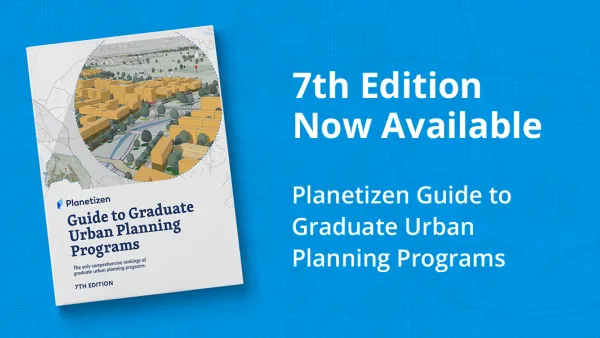The Shanghai Statement creating the Global Planning Education Association Network (GPEAN) was signed by ten planning school associations at the closing ceremony of the 1st World Planning Schools Congress at Tongji University, 20 years ago this week.

In July 2001, four planning school associations representing urban and regional planning schools on four continents convened the first World Planning Schools Congress in Shanghai. In all, 650 scholars from over 250 schools in more than 60 countries met for five days to exchange research results, teaching experiences, and ideas about the future of the urban planning profession. Leaders of the four associations, Asian Planning Schools Association (APSA), Association of Collegiate Schools of Planning (ACSP), Association of European Schools of Planning (AESOP), and Australia and New Zealand Association of Planning Schools (ANZAPS), took the opportunity to convene a meeting of leaders of all the world’s planning school associations. They were joined by six other associations representing schools in Africa, Brazil, Canada, Indonesia, Latin America, and the francophone world, in two days of meetings discussing the potential for future cooperation.
Although the ten associations reflected wide differences in organization, activities and politico-economic contexts, they shared belief in the substantial potential for cooperation to advance planning education and scholarship. At the conclusion of the meetings, they agreed to cooperate on an ongoing basis with what became known as the Shanghai Statement:
Representatives of national and international planning education associations gathered at Tongji University in Shanghai and agreed on the goal of increasing mutual communication in order to improve the quality and visibility of planning and planning education. To achieve this, it was agreed to establish a global planning education association network and committees to plan holding the second World Planning Schools Congress and to develop an inclusive communications network. [1]
The Shanghai Statement was signed in English and Mandarin by the association delegates at the closing ceremony of the WPSC at Tongji University on 14 July 2001. A year later, nine of the associations sent representatives to an organizational meeting of the network in Volos, Greece, held in conjunction with the annual congress of AESOP. A proposed charter prepared in Volos was ratified and signed by the associations on 31 December 2002, establishing the Global Planning Education Association Network (GPEAN), today a network of 11 associations, those already named, plus the Association of African Planning Schools (AAPS), Association of Canadian University Planning Programmes (ACUPP), Latin-American Association of Schools of Urbanism and Planning (ALEUP), National Association of Urban and Regional Post-graduate and Research Programs (ANPUR, Brazil), Association for the Development of Planning Education and Research (APERAU, francophone), Association of Schools of Planning of Indonesia (ASPI), and Turkish Association of Planning Schools (TUPOB). [2]
Currently, GPEAN has an active role in discussions on teaching, research and practice of urban and regional planning on a global scale as a result of that initiative. The network's activities have included four world planning schools congresses, six edited issues of its book series, "Dialogues in Urban and Regional Planning," published with Routledge [3], joint work with UN-Habitat , the International Society of City and Regional Planners, and the Global Planners Network, and in the various academic and professional activities in which its associations’ members participate. With its 11 associations, GPEAN brings together urban and regional planning schools from more than 80 countries, as can be seen in the map below. This week, GPEAN commemorates the 20th Anniversary of the Shanghai Statement, which was the cornerstone for its creation.
[1] Shanghai Statement, Tongji University, Shanghai, July 14th, 2001. https://www.gpean-planning.org/history/
[2] Bruce Stiftel and Vanessa Watson. Building global integration in planning scholarship. Pp. 1-14 in Dialogues in Urban and Regional Planning, ed. by Bruce Stiftel and Vanessa Watson. Routledge: London and New York, 2004.
[3] Routledge, Taylor and Francis. https://www.routledge.com/Dialogues-in-Urban-and-Regional-Planning/book…

National Parks Layoffs Will Cause Communities to Lose Billions
Thousands of essential park workers were laid off this week, just before the busy spring break season.

Retro-silient?: America’s First “Eco-burb,” The Woodlands Turns 50
A master-planned community north of Houston offers lessons on green infrastructure and resilient design, but falls short of its founder’s lofty affordability and walkability goals.

Delivering for America Plan Will Downgrade Mail Service in at Least 49.5 Percent of Zip Codes
Republican and Democrat lawmakers criticize the plan for its disproportionate negative impact on rural communities.

Test News Post 1
This is a summary

Test News Headline 46
Test for the image on the front page.

Balancing Bombs and Butterflies: How the National Guard Protects a Rare Species
The National Guard at Fort Indiantown Gap uses GIS technology and land management strategies to balance military training with conservation efforts, ensuring the survival of the rare eastern regal fritillary butterfly.
Urban Design for Planners 1: Software Tools
This six-course series explores essential urban design concepts using open source software and equips planners with the tools they need to participate fully in the urban design process.
Planning for Universal Design
Learn the tools for implementing Universal Design in planning regulations.
EMC Planning Group, Inc.
Planetizen
Planetizen
Mpact (formerly Rail~Volution)
Great Falls Development Authority, Inc.
HUDs Office of Policy Development and Research
NYU Wagner Graduate School of Public Service






























